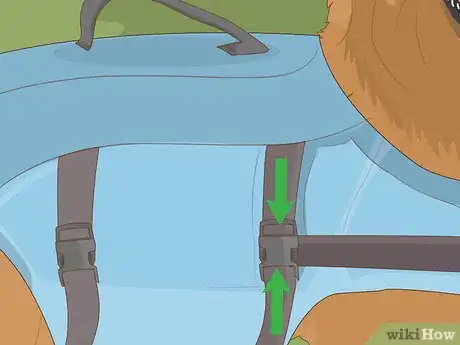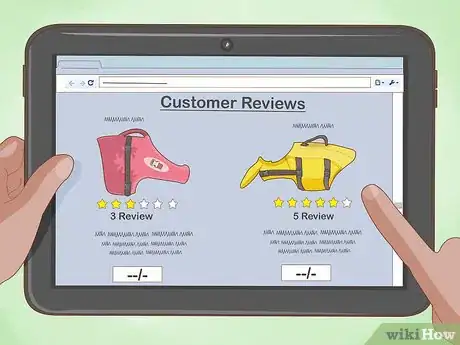This article was co-authored by Pippa Elliott, MRCVS. Dr. Elliott, BVMS, MRCVS is a veterinarian with over 30 years of experience in veterinary surgery and companion animal practice. She graduated from the University of Glasgow in 1987 with a degree in veterinary medicine and surgery. She has worked at the same animal clinic in her hometown for over 20 years.
This article has been viewed 19,874 times.
Not all dogs are water dogs, and even the best of swimmers may need an extra hand now and then when they hit the waves. Having a good life jacket can keep your pet healthy and safe. Figure out if your dog should have a life jacket, and learn how to pick the best one for your pet’s needs. If you know how to take the right measurements and look for the right features, picking a personal flotation device for your pooch is a piece of cake.
Steps
Taking the Necessary Measurements
-
1Weigh your dog. All life jackets are designed for specific weight ranges and will only be effective for dogs who fall within those ranges. Be sure you have an accurate weight for your dog before purchasing a jacket.[1]
- If you have a dog that you can pick up, you can do this using your home scale. Step on the scale to find your weight, and then step on it holding your dog. Subtract your individual weight from the total of yours and your dog’s to find your dog’s weight.[2]
- If your dog is too big to pick up, weigh them using a scale designed for dogs at your vet’s office or local pet store.
-
2Measure your dog’s chest and neck sizes. To fit their jacket properly, you need to know your pet’s girths around their rib cage and neck.
- Circle a string or ribbon from the widest part of their ribs around their back. Mark where the end of the string meets up with the rest; then, measure its length in centimeters and/or inches using a ruler or tape measure.
- Use the same process to measure the girth of the base of your dog’s neck, so you can tell how large an opening their life vest will need.
Advertisement -
3Measure your dog’s length. You need to know the distance between the base of your pet’s neck and the base of their tail to ensure that your canine life jacket provides adequate coverage. Use a tape measure to take this measurement in centimeters and/or inches.
Finding a Good Life Jacket
-
1Make sure it has a durable handle. Life jackets with sturdy top handles make it much easier to pick your dog up out of the water if they should need an extra hand.[3]
- For the same reason, it’s also useful if the jacket has a leash attachment, so that you can pull or guide your dog out of the water.
-
2Choose one with high visibility. Life jackets come in many styles, but it’s important to prioritize functionality over looks. When it comes to the color or pattern, make sure that your dog’s life jacket is bright, neon, and/or has reflective tape so that they’re always visible in the water.[4]
- This is essential not only so that you can keep track of your pet but also so that nearby boaters, swimmers, or surfers can avoid them.
-
3Get one with a front flotation pad. This buoyant pad will keep your dog’s head afloat in case of emergency. Be sure that your canine life jacket has a front flotation device across the chest that’s located immediately under your dog’s chin.[5]
-
4Read the sizing charts. Dogs come in a huge variety of shapes and sizes, and each brand of life jacket will have a different type of sizing system. Be sure that you know the associated weights and measurements for each size when selecting a life jacket.
-
5Make sure it fits. All canine life jackets are adjustable, but that doesn’t mean that they all fit well. The fit is the most important criteria for keeping your dog happy and safe. You want a jacket that is snug and secure on your dog’s body while still allowing them to move freely.[6]
- Test your dog’s mobility by having them walk, sit, lie down, and run in the jacket.
- You want the vest to be snug but not so tight that it’s uncomfortable. When you have the jacket strapped on, be sure that you can fit two fingers between the vest and your dog’s body at the neck opening.
- Be sure that none of the fittings or attachments (like buckles and straps) rub against your dog uncomfortably since that can lead to chafing.
- Most pet stores that carry life jackets will do fittings for you. If you find that your dog’s life jacket does not fit them well, return it, and try another brand or size.
-
6Pick one that’s convenient. You don’t want a jacket that has so many adjustable attachments that it’s difficult to get on and off of your dog. Make sure that you can easily put the jacket on your dog and remove it before purchasing it.
- Many jackets come with handy quick-release buckles, so that they’re simple to slip on and off.
- For convenience’s sake, you should also make sure that the jacket’s material is durable, like sturdy nylon and neoprene, and easy to clean.
-
7Read reviews. Even though you can see in advance if a canine life jacket fits your dog, it’s still difficult to tell if it will actually function well when you hit the lake. Search online for reviews of products that have actually tested them with real dogs in real water.[7]
- Be sure that the reviewers do not have a commercial affiliation with any brand.
Deciding If Your Dog Needs a Life Jacket
-
1Figure out if your dog is a water dog. For some breeds, swimming is not instinctual, and water inspires fear rather than pleasure. That fear can become dangerous when it hampers your pet’s breathing and ability to stay afloat. If your dog panics around water, you should definitely get them a life jacket.[8]
- The list of breeds that are typically water-shy is longer and more various than you might think. It includes everything from English Bulldogs to Chihuahuas to certain types of Terrier. As a general rule, if your dog has short legs or weighs less than 15 pounds, chances are they should have a life jacket.[9]
- Toy dogs are especially prone to being less than enthusiastic about water. If you have a pet that belongs to the Toy group, it’s advisable to get them a life jacket.
-
2Consider your dog’s body fat and coat. Pooches with low body fat and thin coats will find it challenging to regulate their core body temperatures and keep themselves afloat. If you have a trim dog, it’s wise to get them a life jacket.[10]
- Canines with low body fat and short fur include breeds like Greyhounds, Salukis, Whippets, Dobermans, and Boxers.
-
3Assess the condition of your dog. If your pet is not in a peak state of fitness, it’s a good idea to get them a life jacket. They might be a water dog, but illness, old age, lack of exercise, susceptibility to overheating, and/or obesity can seriously affect their swimming abilities.[11]
- If your dog has a seizure disorder, heart condition, or respiratory condition, it’s probably best to keep them out of the water altogether.
-
4Evaluate the water-safety risks. If you’re taking your dog out on a boat or exposing them to potentially dangerous waters, it’s always wise to have a life jacket for them. Likewise, if there’s a chance that your dog will be swimming for a prolonged period, they should have a life jacket on.[12]
- It is not a legal requirement to have a life jacket for dogs on a boat (as it is for all human passengers), but it is highly recommended.
- Significant safety risks include water that is deep, fast-moving, wavy, and/or prone to currents or undertows.
Warnings
- Always err on the side of safety. You never know when an accident may occur, so it’s a good idea to get a life jacket for your dog if they’re going to be near water frequently.⧼thumbs_response⧽
- If you suspect that water is dangerous to swim in due to rough surf, strong currents, and/or uneven terrain, keep your dog out of it altogether.⧼thumbs_response⧽
References
- ↑ http://www.whole-dog-journal.com/issues/6_7/features/Life-Jackets-for-Dogs_5555-1.html
- ↑ https://www.dogfoodadvisor.com/dog-feeding-tips/weigh-your-dog/
- ↑ http://www.boatus.com/pets/dogvest.asp
- ↑ http://www.boatus.com/pets/dogvest.asp
- ↑ http://www.vetstreet.com/our-pet-experts/things-to-consider-when-buying-your-dog-a-life-jacket
- ↑ http://www.vetstreet.com/our-pet-experts/things-to-consider-when-buying-your-dog-a-life-jacket
- ↑ http://www.whole-dog-journal.com/issues/6_7/features/Life-Jackets-for-Dogs_5555-1.html
- ↑ http://www.vetstreet.com/our-pet-experts/things-to-consider-when-buying-your-dog-a-life-jacket
- ↑ http://www.vetstreet.com/our-pet-experts/which-dog-breeds-love-or-loathe-the-water-we-asked-readers-and-experts








































































